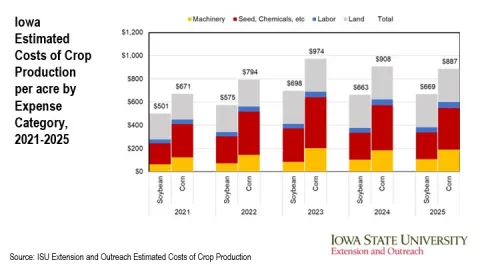The report provides estimates for common crop rotations, including corn following corn, corn following soybeans and corn following silage. The report lists specific costs commonly associated with each crop, including seed, fertilizer, machinery use and labor. Budgets for various production methods are also included, such as low-till and strip-till budgets for corn and soybeans as well as other crops, such as oats, hay and maintaining grass pastures. Machinery costs reflect both new and used equipment and are up 3–4% in the 2025 projections.
Information File, Estimated Costs of Crop Production, https://www.extension.iastate.edu/agdm/crops/html/a1-20.html, includes average production costs for corn, corn silage, soybeans, alfalfa and pasture maintenance. Decision tools, https://www.extension.iastate.edu/agdm/decisiontools.html, as well as web-based calculators, https://www.card.iastate.edu/tools/ag-decision-maker/crops/, are available that allow farmers to enter their own numbers to estimate production costs on their own farm. In addition to the Estimated Costs of Crop Production, the Ag Decision Maker website has enterprise budgets for Livestock,
https://www.extension.iastate.edu/agdm/livestock/html/b1-21.html, as well as annual, https://www.extension.iastate.edu/agdm/crops/html/a1-17.html, and perennial, https://www.extension.iastate.edu/agdm/crops/html/a1-17.html fruits and vegetables.
Due to differences in soil condition, the quantity of inputs used and other factors, production costs will ultimately vary from farm to farm. Labor is treated as a fixed cost in the reports, because most labor on Iowa farms is supplied by the operator, family or permanent hired labor.
While the budgets are scalable to any size, as farms vary in size, there will be an impact on the cost per acre. Fixed costs are costs that are incurred regardless of the level of production, such as depreciation, interest, insurance, and housing. Whereas variable costs, such as fuel, oil, repairs, seed, and chemicals, change in direct proportion to changes in volume (more acres = more variable costs).
Historical estimates of Iowa crop production costs are also available, https://www.extension.iastate.edu/agdm/crops/html/a1-21.html, dating back to 2000.

Farm bill decisions
Other timely tools available in the January Ag Decision Maker update, include decision tools to help farmers select the appropriate farm bill program, https://www.extension.iastate.edu/agdm/crops/html/a1-33.html. Options include Price Loss Coverage and Agricultural Risk Coverage, with options for individual farm coverage or county-level coverage. The tools help farmers analyze and select the best option for their own operation.
The current farm bill has been extended through Sept. 30. With price changes in the projections for ARC-CO and PLC, it is a good time for producers to consider if their current enrollment best fits their operation’s risk management needs. USDA’s Farm Service Agency dates to make changes to program enrollment for ARC and PLC for the 2025 crop year are open from Jan. 21 to April 15, 2025.
Source : iastate.edu